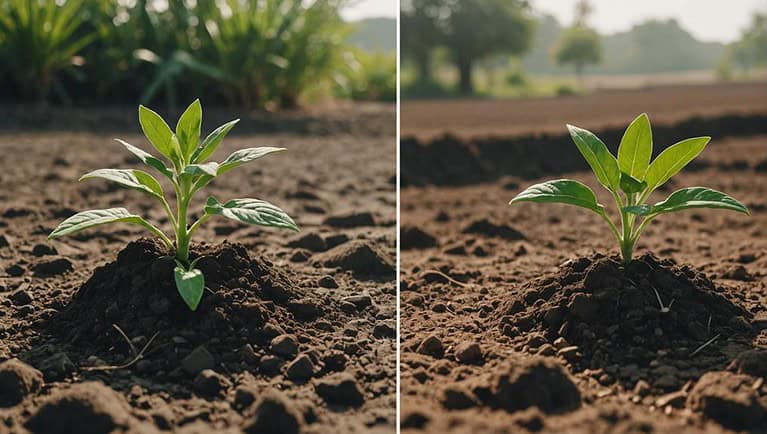How Long Does It Take for Grass to Dry After Rain
Are you wondering how long your grass can dry after heavy rain or watering? The answer is not as simple as a set amount of time, as several factors affect the drying process. Understanding these factors can help you determine when it’s safe to walk or mow on wet grass without causing damage to your lawn.
One of the primary factors affecting how long grass takes to dry is climate and weather conditions. Humidity levels, temperature, and wind speed all affect the drying process. For example, high humidity levels can slow evaporation, while warm temperatures and breezy conditions can speed up the process.
Other factors, such as soil type and drainage, also impact drying time, with sandy soils draining faster than clay soils typically found in areas with poor drainage.
This article delves deeper into these variables and provides tips for caring for your lawn after rainfall or watering.
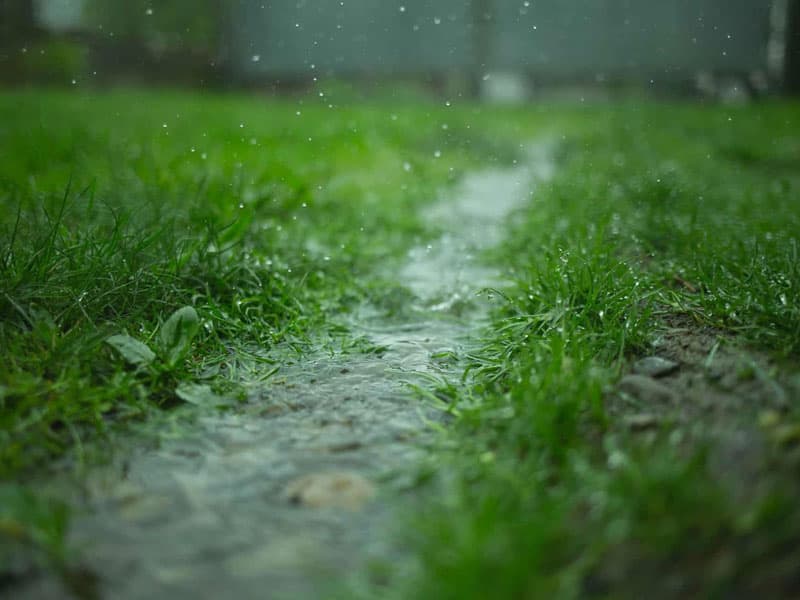
Factors Affecting Drying Time of Wet Grass
When it comes to the drying time of wet grass, several factors play a crucial role in determining how long it takes for your lawn to dry out.
The intensity of the rain, soil type (clay vs. sandy), grass blades’ height and density, environmental conditions such as temperature and humidity, and how much water is on the lawn all contribute to this process.
Understanding these factors can help you plan when to mow your lawn after rain and avoid damaging your grass by walking or mowing it while still wet.
The Intensity of the Rain
The intensity of the rain plays a crucial role in determining how long it takes for wet grass to dry. Heavy rainfall takes longer to evaporate, so the more water that saturates the lawn, the longer it will take for the grass blades to dry out completely. After a heavy downpour, you may need to wait several days before mowing your lawn safely. Walking or using a mower on wet grass can cause damage and lead to brown spots or other issues down the road.
However, even after the surface appears dry, some moisture may still be retained within the grass blades themselves. With this in mind, it’s always best to avoid caution and wait until you’re confident that your lawn is parched before attempting maintenance.
Let’s move on to our next step: examining how soil type affects drying time. (Learn How To Tell If Dehumidifier Is Working)
Soil Type: Clay vs. Sandy Soil
If you’re wondering how the type of soil in your lawn affects its drying time, take note that clay soil and sandy soil have drastically different moisture retention rates.
Sandy soils dry out much faster than clay soils due to their high rates of percolation and evaporation, whereas clay soils have low absorption and percolation rates.
This means grass growing on sandy soil will dry faster after a rain shower than those growing on clay soil.
The moisture content of the soil can affect how long it takes for the grass to dry after rain, so it’s essential to consider the type of soil in your lawn when planning maintenance tasks like mowing.
With this in mind, let’s move on to the next section about grass blades: height and density.
Grass Blades: Height and Density
Achieving a lush and healthy lawn is every homeowner’s dream, and one way to accomplish this is by paying attention to the height and density of grass blades.
When determining how long it takes for wet grass to dry after rain showers, it’s essential to consider the height and density of the lawn. Longer grass helps shades its roots, which can protect against drought and heat stress. However, denser properties can retain moisture for extended periods, causing them to take longer to dry after rainfall.
It’s best to wait until the grass is dry before mowing it after rain showers. Mowing wet grass can cause long-term damage, leading to brown spots or other damage.
In the subsequent section about environmental conditions: temperature, and humidity, we will explore additional factors that affect how quickly wet grass dries after rainfall.
Environmental Conditions: Temperature and Humidity
Wow, the scorching heat and unbearable humidity can make even the driest grass take forever to dry after a downpour. The environmental conditions of temperature and humidity play a critical role in determining how long it takes for wet grass to dry.
High humidity levels slow the evaporation process, while warm temperatures speed up the drying process. When mowing a lawn, waiting until the grass is dried is crucial to avoid damage caused by the bending or breaking of grass blades.
Keeping an eye on these environmental conditions will help you determine when mowing your lawn is safe without causing any harm.
Now let’s move on to the next step: how much water is on the lawn?
How Much Water is on the Lawn?
Now that we’ve covered the impact of temperature and humidity on grass drying time let’s move on to the amount of water on your lawn.
The amount of water present is crucial in determining how long it takes for wet grass to dry. Grass dries faster after light rain than heavy rain, which may take 2-4 days to dry.
Additionally, the volume of water on your lawn affects how long it will take for the grass to dry out thoroughly. If you’re unsure whether your property is ready for mowing, check for visible water droplets or dampness underfoot.
Walking or mowing wet grass can cause damage, leading to brown spots or other issues down the line. Explore this further by discussing how long you should wait before mowing wet grass without damaging it.
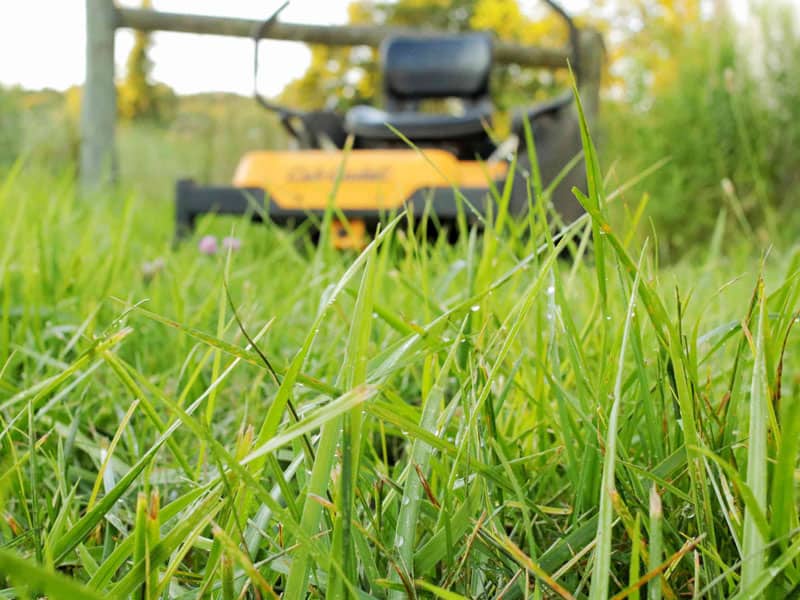
How Long Should I Wait to Mow Wet Grass?
When mowing wet grass, assessing whether the grass is dry enough before you start is essential. Factors like light rain vs. heavy rain showers and temperature can affect how long your lawn dries out.
If you mow too soon, you risk damaging your grass, leading to brown spots or other issues down the line. In this discussion, we’ll explore when it’s safe to mow wet grass, the consequences of cutting too early, and alternatives if your lawn isn’t dry enough yet.
Assessing Grass Dryness
To check if the grass is dry enough to mow, you can walk across without getting wet shoes or look for visible water droplets on the blades. Assessing grass dryness before mowing is crucial to prevent damage to your lawn. An excellent way to gauge whether your grass is ready for mowing after a heavy rain or watering session is by checking the soil dryness and drying time factors such as temperature, humidity, and wind speed. The table below shows how long grass can dry under different weather conditions and soil types.
| Weather Conditions | Soil Type | Drying Time |
|---|---|---|
| Light Rain | Sandy | 1-2 hours |
| Clay | 24-48 hours | |
| Heavy Rain | Sandy | 2-4 days |
| Clay | 48+ hours |
Mowing wet grass can cause harm to your lawn’s health and be dangerous, so always wait until the blades are completely dry before starting. While light rain doesn’t usually require a waiting period, it’s best practice always to assess whether your lawn is suitable for mowing by following the tips above. Transitioning into discussing ‘light rain vs. heavy rain showers,’ let’s explore how weather conditions affect grass drying times in more detail.
Light Rain vs. Heavy Rain Showers
In lawn care, light rain is like a gentle kiss on the cheek, while heavy rain showers are more like a full-on drenching – and understanding how they affect grass drying times is critical to maintaining a healthy yard.
When determining how long it takes for wet grass to dry, it’s important to note that light rain showers typically only add moisture to the surface of the grass and can help with growth.
However, heavy rain showers soak deep into the soil, taking up to 2-4 days for the grass to fully dry out. This extended drying time means it’s crucial to wait until the grass is dried before attempting to mow the lawn, as walking or mowing on wet soil can lead to root damage and an unhealthy property.
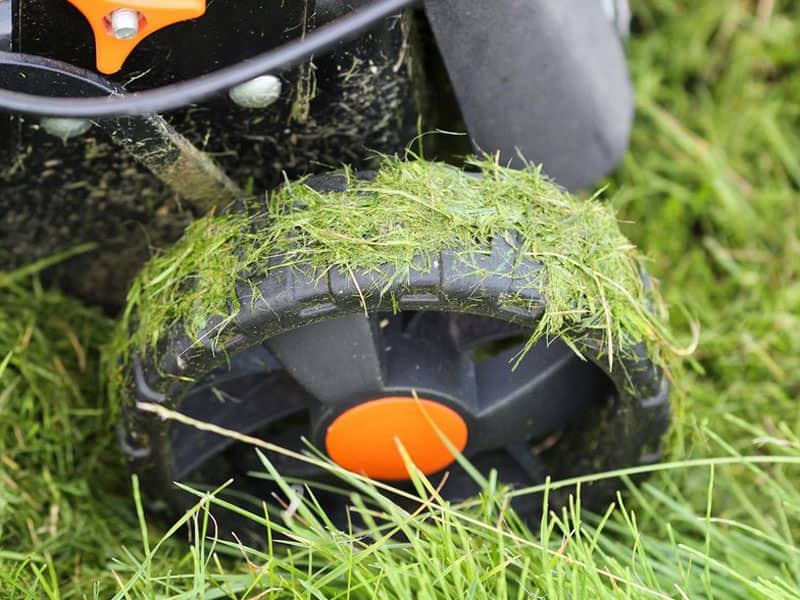
When is Wet Grass Dry Enough to Mow?
You may wonder if mowing your lawn after a rain shower is safe, but how do you know when the wet grass is dry enough?
The answer depends on various factors such as the amount and intensity of the rainfall, humidity levels, soil type, and temperature. Generally speaking, grass can take a few hours to several days to dry after rain.
Heavy rains or shaded areas may take longer to dry than sunny days or well-drained soils. It’s crucial to wait until the grass is dried before cutting it because mowing wet grass can lead to long-term damage like brown spots or uneven growth.
In short, always check for water droplets and wet shoes before deciding whether your lawn is dry enough for mowing to avoid potential consequences.
The Consequences of Mowing Wet Grass
It’s funny how you might think mowing wet grass is a good idea, but it can lead to damaging consequences for your lawn. Before cutting damp grass, remember that the moisture on the blades makes them more prone to tearing and shredding than being cut cleanly.
Waiting until the grass is dry will give it time to regain its rigidity and prevent damage. When grass is wet, it tends to clump together instead of falling uniformly, leading to an uneven cut and leaving behind unsightly patches of longer or shorter grass.
Furthermore, if you mow while the grass is exposed to humid conditions, fungal diseases can spread more easily since moisture encourages growth. Lastly, walking or using heavy equipment on a soggy lawn can compact soil and damage roots which can cause long-term harm even after the surface has dried out.
So please wait until the grass is dry before cutting it and avoid the consequences of mowing wet grass. Moving forward, let’s talk about alternatives to mowing damp grass.
Alternatives to Mowing Wet Grass
Consider other options for wet lawn maintenance, as mowing can lead to damage and uneven cuts. Instead of cutting damp grass, focus on tasks that don’t require walking on or cutting the grass, such as trimming hedges or removing weeds.
If you must work on your lawn while it’s still damp, use a leaf blower to dry off the surface of the grass before walking on it. You can also try laying down boards or plywood to distribute your weight more evenly across the lawn and reduce the risk of damaging individual blades of grass.
Waiting for dry conditions is the best alternative to mowing wet grass. To determine when your lawn is dry enough to cut, check for visible water droplets and avoid walking across areas where you see them.
Determining When Your Grass is Dry
Check the soil for dryness to determine when your grass is dry enough to mow. The time it takes for the soil to dry depends on various factors such as weather conditions, soil type, and depth. Different types of grass also have other drying times.
If your grass stays wet for too long, some methods can speed up drying, like raking water off the surface or using a hose to push water toward sidewalks.
Checking the Soil for Dryness
If you want to check if the soil is dry enough for mowing, walk across it and feel for any moisture with your shoes. It’s essential to wait until the grass and dirt are parched before mowing to avoid damaging the lawn.
The amount of time it takes for the grass to dry depends on weather conditions, soil type, and rainfall. Generally, it takes 24 hours to 3 days for lawns to dry after rain. In spring, it may take up to three days for the grass to completely dry out; in summer or sunny conditions, one day is sufficient.
Soil composition, topography, and drainage affect water absorption in the yard, so determining how long it takes can vary depending on these factors. Waiting for optimal drying conditions will help ensure a healthy lawn in the long run.
Now let’s move on to understanding how long soil dries takes.
How Long Does it Take for Soil to Dry?
Determining soil moisture is crucial for maintaining healthy plant life, and understanding the factors that affect soil drying time can help prevent overwatering or underwatering your lawn.
The amount of time it takes for the soil to dry depends on various factors, including weather conditions, soil type, frequency of rain, and shade.
After rainfall, grass may stay wet for up to 24-72 hours, depending on these factors.
It’s essential to wait until the grass is dry enough to cut before mowing your lawn, as cutting wet grass can lead to unhealthy lawn growth.
Remember that while sandy soils typically dry out more quickly than clay soils, compacted soils like clay may take up to 48 hours to dry after heavy rain.
In the next section, we’ll explore how long different types of grass take to dry.
How Long Do Different Types of Grass Take to Dry?
When you’re waiting for your lawn to dry after a rainfall, different types of grass will have varying drying times based on factors like soil type and weather conditions. The table below summarizes the estimated drying times for four common types of grass: Bermuda Grass, Kentucky Bluegrass, Zoysia Grass, and St. Augustine Grass. These estimates assume mild temperatures (60-75 degrees Fahrenheit) with no wind or direct sunlight. As you can see from the table, Bermuda grass dries the fastest in just 1-2 hours, while St. Augustine takes the longest at 24 hours or more. Remember that these are just estimates and that actual drying time can vary depending on specific conditions such as rain intensity and duration, humidity levels, the slope of your lawn, and soil drainage quality.
| Type of Grass | Estimated Drying Time |
|---|---|
| Bermuda | 1-2 hours |
| Kentucky Blue | 4-6 hours |
| Zoysia | 8-10 hours |
| St. Augustine | 24+ hours |
To speed up grass drying time, there are several methods you can try, such as using a leaf blower to remove excess water or raking the surface to allow better air circulation.
Methods to Speed Up Grass Drying
To speed up the drying process of your wet lawn, try using a leaf blower or rake to remove excess water and improve air circulation. Factors such as soil type, humidity levels, and wind speed can impact how long grass dries after rain stops, but these steps can help expedite the process.
Additionally, avoid walking or mowing on wet grass, as this can cause damage and remove nutrients from the soil. If your grass stays wet for too long, there are other steps you can take to address poor drainage and prevent further damage to your lawn. (Read Grass Turning White – What To Do)
What to Do if Grass Stays Wet for Too Long
If your lawn remains soggy, add more drainage channels and plant vegetation to prevent further water buildup. Additionally, you can aerate the soil to improve drainage and reduce soil compaction that prevents water from percolating.
If excessive rainfall persists, avoiding walking or mowing wet grass is essential, as it can lead to brown spots and other damage. Instead, wait until the grass has dried out entirely before cutting. Healthy grass needs a balance of moisture and dryness for optimal growth, so taking steps to prevent water buildup in the first place is crucial for maintaining a thriving lawn.
With proper care and attention, you can ensure that your grass remains healthy even during periods of heavy rain. How much water does grass need between rain showers?
How Much Water Does Grass Need Between Rain Showers?
To ensure your lawn stays healthy and lush, it’s crucial to water it regularly. Knowing how often to water your property can be challenging, but calculating how much your grass needs is critical.
Best practices for watering grass include deep watering infrequently and adjusting schedules based on rainfall. It’s essential to monitor your lawn for signs of overwatering or underwatering and adapt as needed to keep your grass thriving.
How Often Should You Water Your Lawn?
Consider climate, soil type, and grass species when watering your lawn. Knowing how often to water your property requires keeping the grass hydrated enough to thrive and avoiding overwatering that can cause root rot or disease.
If you water too much, your lawn may not have time to dry out completely before the next watering session, leading to a buildup of moisture that can make it harder for grass to dry after rain. Spring rain showers can help provide natural hydration for your lawn, but check whether your grass is dry before mowing or walking on it.
The time it takes for grass to dry depends on factors like soil drainage, humidity levels, and weather conditions. So, how often should you water your lawn? Calculating the amount of water your lawn needs is essential in determining the frequency and duration of watering sessions.
Calculating the Amount of Water Your Lawn Needs
Calculating the water your lawn needs is crucial for maintaining a healthy and thriving lawn. To determine how much water your grass needs, you must consider various factors such as the soil type, weather patterns in your region, and the type of grass you planted.
It takes around 24 to 72 hours for wet grass to dry, depending on rainfall intensity and duration, humidity levels, temperature, and soil type. It’s essential to wait until the grass is dry before mowing or walking across it to avoid damaging the blades or root system.
However, remember that overwatering can also harm your lawn’s health. The amount of water your lawn needs depends on factors such as climate conditions in your area and the type of soil present.
To ensure optimal growth and appearance of your lawn while avoiding damage from overwatering or underwatering, following the best practices for watering grass regularly is essential.
Best Practices for Watering Grass
Watering your lawn correctly is essential for maintaining healthy and lush grass. To ensure proper watering, follow these three tips:
1) Water deeply and infrequently to encourage roots to grow deep into the ground.
2) Water early in the morning or late in the evening when temperatures are more relaxed and less evaporation.
3) Adjust the watering frequency based on weather conditions, such as rain or humidity.
Overwatering can lead to soggy shoes and promote fungal growth, while underwatering can cause dryness and brown spots on the grass.
In the next section, we’ll discuss how to tell if your lawn is overwatered or underwatered without relying on a step-by-step guide.
How to Tell if Your Lawn is Overwatered or Underwatered
If you’re unsure whether your lawn is getting excellent water, there are a few signs to look out for.
Overwatered grass may have yellowing leaves and feel spongy when walked on, as well as having standing water or puddles at the bottom of a hill.
Underwatered grass may have brown patches or wilted leaves, and the ground may be dry and cracked.
Additionally, if you notice that the grass after rain looks damp rather than wet with visible droplets, this could indicate that your lawn is not absorbing water properly due to overwatering or compacted soil.
Proper watering helps the grass grow healthy and robust, so monitoring these indicators and adjusting your watering schedules based on rainfall is essential. (Read About St Augustine Bermuda Mix)
Adjusting Watering Schedules Based on Rainfall
Adjusting your watering schedule based on rainfall is crucial for maintaining a healthy lawn. To ensure that your grass dries within a reasonable timeframe after rain, you should keep track of the humidity levels in your area and adjust your watering schedules accordingly.
If it’s humid outside, you may need to water less frequently than if it’s dry within several days after rain. Remember that grass can take 2-4 days to dry completely after a shower, so be mindful of how much water you give your lawn.
Adjusting your watering schedules based on rainfall and humidity levels can help prevent overwatering or underwatering your lawn and promote healthy growth. With proper care, you can keep your grass looking its best, even during rainy seasons.
Now let’s move on to discussing mowing and lawn care after rain.
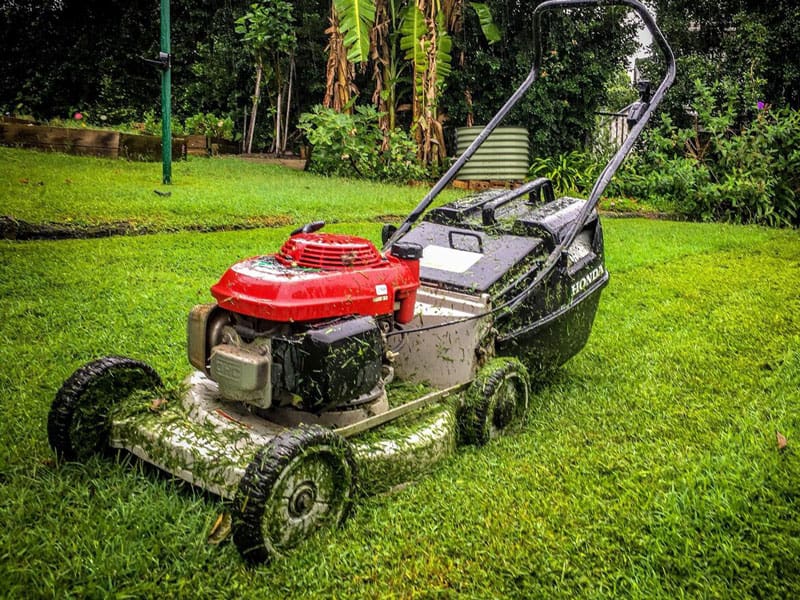
Mowing and Lawn Care After Rain
When it comes to mowing your lawn after rain, safety is critical. Before starting, ensure the grass is dry enough to avoid damage and accidents. Consider using a bag attachment or raking them up afterward to manage heavy grass clippings.
While it’s generally best to wait for the grass to dry before cutting it if you must cut wet grass, make sure your mower blades are sharp and ready for the job. Additionally, there are several other lawn care tips you should keep in mind during and after rain showers to ensure a healthy and beautiful lawn.
How to Mow Your Lawn Safely After Rain
To safely mow your lawn after rain, it’s important to remember that walking or mowing on wet grass can cause long-term damage.
First, wait until the grass has thoroughly dried before mowing. This may take anywhere from 24 hours to 3 days for the grass to dry, depending on factors like weather conditions, soil type, and saturation levels. To know how long it will take for the grass to dry in your area, consider climate and season and the duration/intensity of rain.
Once you’ve determined that the grass is dry enough, check by walking across it without getting wet shoes–this indicates that the grass is ready for mowing.
Finally, when you begin cutting your lawn, be sure not to cut more than one-third of its length at a time to avoid damaging the roots and leaving heavy clippings behind. The following section will discuss rich grass clippings in further detail.
Managing Heavy Grass Clippings
Dealing with many grass clippings can be a hassle, but there are ways to manage them effectively. When mowing the lawn, it’s important to remember that the amount of grass clippings generated depends on how often you trim and the height at which you cut your grass.
If you mow frequently, you’ll generate more clippings and keep your grass shorter. On the other hand, if you let your grass grow too long before cutting it, you may end up with large amounts of clippings that are difficult to manage.
If it’s humid outside, it may take longer for your grass clippings to dry up completely. However, under normal conditions, grass will take about two weeks to decompose and become part of the soil again.
Remember that wet grass clippings can smother your lawn and lead to fungal growth that can damage your grass and plants. With this in mind, ensuring your grass is dry within 24-48 hours after mowing before leaving any clippings behind is essential.
In the next section, let’s consider whether cutting wet grass is safe.
Should You Cut Wet Grass?
Cutting wet grass can be risky, but it’s tempting if you’re short on time. However, it’s essential to consider that cutting wet grass can lead to clumping and uneven mowing results.
If the grass is too wet, the mower blades may not cut through the water droplets effectively and instead push them down towards the soil, leading to a soggy mess. Additionally, if morning dew or rain falls shortly before mowing, the moisture can clog up your lawn mower deck and cause damage over time.
Depending on weather conditions and soil type, it takes 24 hours to 3 days for the grass to dry after rain. Therefore, waiting until the grass has thoroughly dried out before mowing is best to avoid clumping or damaging your lawn mower blades.
In the next section, we’ll discuss keeping your lawn mower blades sharp and ready for wet grass without writing “step.”
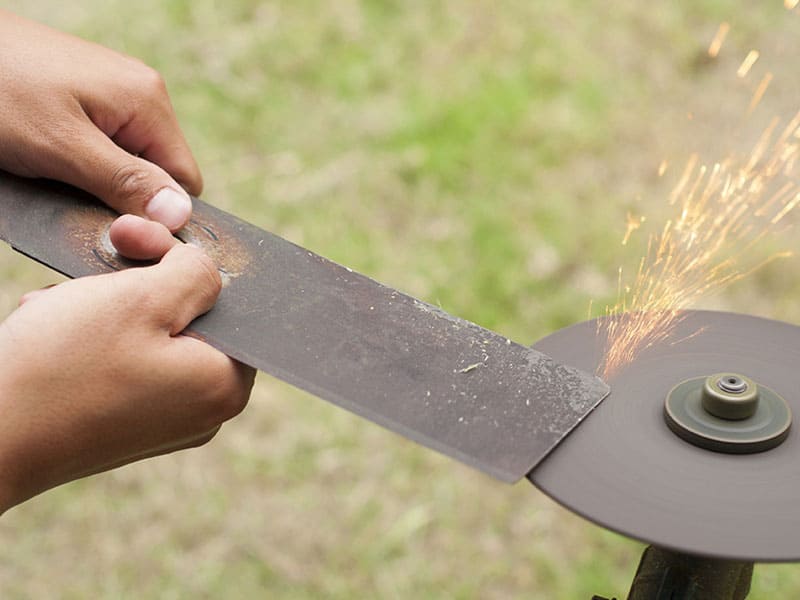
How to Keep Your Lawn Mower Blades Sharp and Ready for Wet Grass
You’re probably thinking, ‘Great, wet grass and dull mower blades – what could go wrong?’
Let’s talk about how to keep those blades sharp and ready for the challenge.
First, ensure the blades are sharpened regularly, as dull blades can damage the grass and the mower.
When mowing in humid conditions or after rain, it’s essential to wait until the grass is dry enough to avoid clumping or uneven cutting. Check for visible water droplets and walk across the lawn without getting wet shoes before starting.
Mow higher than usual to avoid stressing out the grass and causing long-term damage.
By following these tips, you can ensure a clean and precise cut, even on damp grass.
Now let’s move on to additional lawn care tips during and after rain.
Additional Lawn Care Tips During and After Rain
Now that you have learned how to keep your lawn mower blades sharp for wet grass let’s discuss additional lawn care tips during and after rain. It is essential to know when mowing your lawn after rain is okay. If the grass on your property is exposed to humid conditions, it may take longer to dry out. However, typically within a day or two, depending on weather conditions, the grass should be dry enough to walk on without getting your shoes wet. Morning dew can also dampen the grass and require more drying time. To help visualize this drying process, refer to the table below, which outlines estimated drying times based on various factors affecting grass drying time.
| Factors Affecting Grass Drying Time | Estimated Drying Time |
|---|---|
| Climate | 1-3 days |
| Weather After Rain | One day |
| Soil Type | Varies |
| Yard Slope | Varies |
Remember, walking or mowing wet grass can cause long-term damage, so it is best to wait until the grass has thoroughly dried before doing any activity.
Conclusion
Now that you know the factors that affect the drying time of wet grass, you may be wondering how long you should wait before mowing it. Generally, it’s best to wait until your grass is parched before cutting to prevent damage and promote healthy growth. Depending on the conditions, this can take anywhere from a few hours to a full day,
Use the footprint test to determine when your grass is dry enough for mowing.’ Simply step onto your lawn and observe whether or not your footprints are leaving indentations in the soil. If they are, it’s still too wet to mow. Once your prints are no longer visible, you can safely start cutting.
Proper lawn care after rain involves patience and allowing enough time for your grass to dry completely. Following these tips and improving drainage in problem areas, you can keep your lawn healthy and beautiful year-round. Remember: patience goes a long way in maintaining a lush green landscape.



